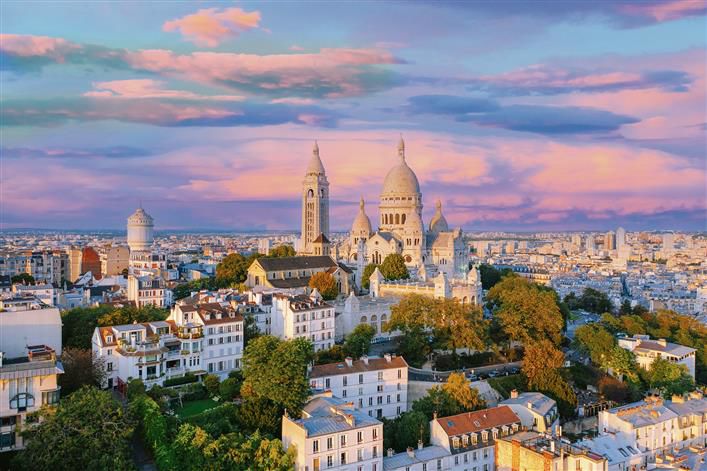Moveable feast: The magic of Paris, which is hosting the Olympics, unfolds through its literary, art, culinary and architectural marvels
Rajnish Wattas
Ernest Hemingway described Paris as a ‘moveable feast’. You carry it in your heart wherever you go. As the venue of the 2024 Olympics from July 26 to August 11, it will make a million hearts pound. The magic of Paris unfolds through its large number of historical, cultural, literary, culinary, art and architectural marvels, besides other attractions.
The soul of Paris, the historic Notre-Dame, the Gothic 12th century cathedral, with its flying buttresses and gargoyles, stands on a small island in the Seine river. In 2019, it got ravaged by a horrific fire, but is now nearing reconstruction with legendary French zeal.
Another place that reaffirms the Paris of art and culture is the iconic Musée du Louvre. Originally built as a chateau in the French Renaissance style, it underwent modifications in 1876 for its new role as the repository of French art treasures and the biggest museum in the world. If you are patient enough to endure the long, serpentine queues, you can get a fleeting view of the iconic Mona Lisa by Leonardo da Vinci.
In 1900, Paris was playing host to the Exposition Universelle and undertook a number of building projects, which included the construction of Pont Alexandre III, the Grand Palais and the smaller but similar Petit Palais. The Grand Palais is one of Paris’ most visible and recognisable landmarks, thanks to its magnificent glass-domed roof. All these monuments are also locations of some events for the Olympics.
To talk of Paris and not mention the Eiffel Tower would be like ignoring the soul of the city. The Eiffel Tower (French: Tour Eiffel) is an iron tower built on the Champ de Mars, beside the Seine. It is the tallest structure in Paris, and among the most recognised symbols in the world. Named after its designer, engineer Gustave Eiffel, it stands at a height of 986 feet. At the time of its construction in 1889, it was the tallest structure in the world. If you can afford it, by all means have lunch at the Michelin-starred restaurant at its level two.
The Place des Vosges is Paris’ oldest square. It is located in le Marais, built by Henri IV in 1612. It’s a majestic square and symbolises the finest of public squares for which the city is so famous. Writer Victor Hugo lived here once.
Demonstrating Paris’ capacity for reinvention is the Musée d’Orsay on the left bank of the Seine. It was once a bustling railway station, but was later turned into a museum holding mainly French art dating from 1848 to 1914. It’s most famous for its collection of Impressionist art and is currently hosting year-long celebrations of ‘150 Years of Impressionism’.
The free heart and spirit of Paris is best reflected at Montmartre, inhabited by artists amid its roadside cafes and stalls. Perched at the highest point of the city is the Basilica of Sacré Cœur, built in 1912. This landmark is built in Romanesque revival style, and can be seen above the city skyline. Just below it, artists still set up their easels each day with their colourful umbrellas, hoping to paint the world’s next ‘masterpiece’.
More than just historic buildings, Paris is much about its grand boulevards, avenues, parks, majestic trees, urban management and conservation. Its magnificence lies in its history. In 1853, Napoleon III embellished the city with monuments and public buildings that made it a world centre for various arts, artists and intellectuals seeking their inspiration from its new vistas. He also developed majestic gardens and large open spaces all over the city, from ‘royal’ gardens such as the Tuileries, designed with neat geometric forms and wide, gravel boulevards in typical French renaissance style, to ‘English-style gardens’. No visitor to Paris comes back without experiencing the majesty of the nearby Chateau de Versailles and its garden — creation of Andre Le Notre, and the emperor Louis IV. The most significant element of these landscapes, however, is the presence of the geometrically-clipped London Plane trees, known in France as the platane à feuille d’érable (‘Maple Leaf Plane’). No one can miss their majestic rows along the grandiose Avenue des Champs-Élysées.
Before you leave, take a night cruise on the Seine. It’s the most ethereal experience of romancing the city of love. You can leave Paris but it will never leave you. As I gaze at the print of Camille Pissarro’s painting, ‘Avenue de l’Opera’, hanging in my study, I walk its boulevards again.
Unlock Exclusive Insights with The Tribune Premium
Take your experience further with Premium access.
Thought-provoking Opinions, Expert Analysis, In-depth Insights and other Member Only Benefits
Already a Member? Sign In Now










